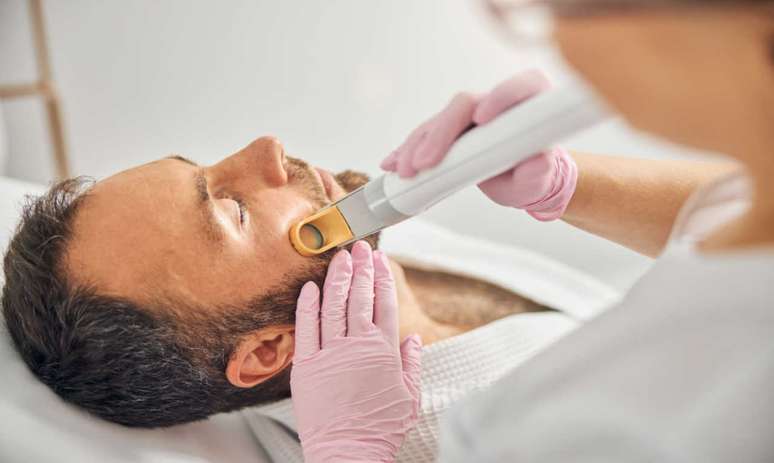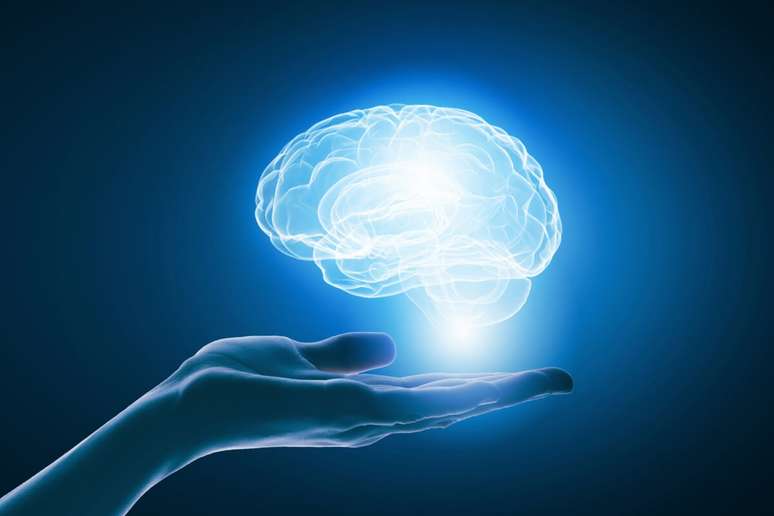Laser therapy does not cause pain, side effects or scars and can be used in various treatments, from oral health to postpartum
No pain, no side effects and no scars. These are some of the benefits of laser therapy, a technique that uses light sources to treat various medical conditions.
html[data-range=”xlarge”] figure image img.img-2ffe10cc3fc952e0f4264ab52d43b0587ywwsoom { width: 774px; height: 463px; }HTML[data-range=”large”] figure image img.img-2ffe10cc3fc952e0f4264ab52d43b0587ywwsoom { width: 548px; height: 328px; }HTML[data-range=”small”] figure image img.img-2ffe10cc3fc952e0f4264ab52d43b0587ywwsoom, html[data-range=”medium”] figure image img.img-2ffe10cc3fc952e0f4264ab52d43b0587ywwsoom { width: 564px; height: 337px; }
How does the use of laser work?
According to Renata Iak, obstetrician and midwifery nurse, the low-power therapeutic laser is the most modern and effective treatment for wounds. This is because it provides rapid skin improvement, no side effects and is easy to apply.
“There are two types of low-power lasers: red and infrared. Red laser regulates healing. Infrared reaches greater depths, so it is best applied for an analgesic effect, in the inflammatory and reparative process,” explains Renata.
Laser therapy stands out as a biostimulator for tissue repair, increasing local circulation, cell proliferation and collagen synthesis. “When laser light interacts with cells and tissues in the right dose, it can stimulate certain cellular functions, such as defense system, increased energy production and proliferation of various cell types, thus promoting anti-inflammatory effects. ‘ says the nurse.
“Compared to other treatments, laser therapy offers several potential advantages, although its effectiveness may vary depending on the specific case and the pathology being treated,” says the pediatric dentist of the IGM Odontopediatria clinic, Dr. Ilana Marchesi. The specialist indicates some of the advantages usually associated with laser therapy. Watch:
5 advantages of laser therapy
Non-invasive: Laser therapy is a non-invasive treatment, meaning it does not require any surgical incisions or aggressive procedures. It uses low-intensity light to penetrate the skin without causing pain or significant damage to surrounding tissue.
Low risk of side effects: the technique carries a relatively low risk of serious side effects, provided it is administered correctly by trained professionals. Compared to more invasive treatments such as surgery or oral medications, laser therapy generally has a better safety profile.
Promotes healing and regeneration: Laser light has the ability to stimulate cell metabolism and increase the production of adenosine triphosphate (ATP), which is the main source of energy for cells. This can speed wound healing, promote regeneration of damaged tissue and reduce recovery time.
Pain Relief: laser therapy is capable of relieving pain in a variety of conditions, such as arthritis, sports injuries, muscle and joint pain, chronic pain, among others. The laser light helps reduce inflammation, increase blood circulation and stimulate the release of endorphins, natural chemicals that act as pain relievers.
Versatility: it suits different medical conditions and, moreover, you can apply it to different parts of the body. It can be used to treat wounds, muscle injuries, inflammation, dermatological problems, chronic pain, among others. This is because there are different types of lasers with specific properties that can be adjusted as needed.
“It is important to note that the effectiveness of laser therapy can vary depending on the condition being treated, individual patient response, and proper application of treatment. It is essential to consult with a qualified healthcare professional to determine if laser therapy is the right option for your specific case.”, Ilana points out.
laser therapy in dentistry
One of the areas of medicine that benefits the most from the technique is dentistry. According to Ilana, laser therapy is a treatment option for several oral health conditions and the practitioner mentions some of the main indications:
Treatment of oral lesions: this is the case of aphthous ulcers (thrush), cold sores, recurrent aphthous stomatitis and geographic tongue, oral candidiasis, hard and soft tissue trauma. Laser light accelerates healing, relieves pain, reduces inflammation of these lesions and reduces the viral, bacterial and fungal load.
oral surgery: The technique assists in the removal of excess gum tissue (gingivectomy), the treatment of periodontitis (periodontal therapy), the removal of soft tissue (excision of lesions), frenectomies (removal of the labial or lingual frenulum), and implant surgery. The laser can offer benefits, such as no bleeding, a better postoperative period and faster healing, as well as eliminating the need for sutures.
Endodontic treatment: it is an option for root canal treatments (endodontics) to disinfect the root canal system. The laser can help eliminate bacteria present in root canals and improve decontamination, increasing the chances of treatment success.
Teeth whitening: the laser light activates the whitening gel, speeding up the whitening process. This technique can provide faster results than traditional whitening.
Treatment of tooth sensitivity: Tooth sensitivity is pain or discomfort caused by exposure of the dentin (inner layer of the tooth). The laser can help seal the exposed dentinal tubules, reducing sensitivity.
Treatment of temporomandibular joint disorder (TMJ): Laser therapy can be part of a comprehensive treatment plan for TMJ dysfunction as it helps reduce pain, inflammation and improve joint function.
Postpartum laser therapy
Renata points out that laser therapy can bring many benefits to women’s health in the postpartum period. “Laser therapy acts as an analgesic, anti-inflammatory, has healing capacity and wound regeneration (nipples, operating wounds, lacerations, episiotomy). In addition, it acts on operating wound from caesarean section, perineal laceration, episiorrhaphy and edema. It can be used to combat candidiasis of the nipple,” informs the practitioner.
The application is painless and non-invasive. There are no contraindications for breastfeeding and it also requires no medication or other preparation, preventing side effects such as bacterial and fungal infections from open wounds, abscesses and mastitis.
“Laser therapy does not cause heating or burns. Its application is quick and safe, but must be performed by a qualified healthcare professional specializing in anatomy and physiology, wounds, and clinical management of breastfeeding, to ensure an accurate assessment. and targeted treatment,” explains Renata.
Treatment and contraindications
While laser therapy is generally considered safe and has few side effects, there are some contraindications and possible risks associated with its use, Ilana cautions. “Importantly, the safety profile of laser therapy may vary depending on the type of laser, treatment parameters, patient condition, and the expertise of the practitioner performing the procedure,” she says. The specialist leaves some important considerations:
eye protection: It is essential to protect your eyes during laser therapy, as direct exposure to laser light can damage the retina and impair vision. Both the patient and the healthcare professional should wear appropriate protective eyewear to avoid any risk to the eyes.
Pregnancy: Pregnant women should avoid laser therapy, especially in the abdominal and pelvic area, due to lack of sufficient data on the effects of laser exposure on the developing fetus. It is important to discuss any laser treatment with your doctor while you are pregnant.
Cancer: in general, laser therapy is not recommended directly on cancerous tumors unless it is part of a specific cancer treatment such as photodynamic therapy. It is important to discuss laser therapy with your oncologist or cancer specialist before starting any procedures.
light sensitivity: some people may be more sensitive to light and may experience adverse reactions, such as burning or uneven skin pigmentation, in response to laser therapy. Before proceeding with the treatment, a careful assessment of the skin and individual response is necessary.
Specific conditions: there are some medical conditions in which laser therapy may be contraindicated or require additional precautions. This includes active infections, blood clotting disorders, sensitivity disorders, history of epilepsy or seizures, among others. A qualified healthcare professional should evaluate these conditions before recommending laser therapy.
Source: Terra
Ben Stock is a lifestyle journalist and author at Gossipify. He writes about topics such as health, wellness, travel, food and home decor. He provides practical advice and inspiration to improve well-being, keeps readers up to date with latest lifestyle news and trends, known for his engaging writing style, in-depth analysis and unique perspectives.






![Everything starts here: What are you waiting for on Tuesday, July 22, July 22, 2025 [SPOILERS] Everything starts here: What are you waiting for on Tuesday, July 22, July 22, 2025 [SPOILERS]](https://fr.web.img2.acsta.net/img/52/4a/524a493b6d4b1233fce62af9a6caf759.jpg)


